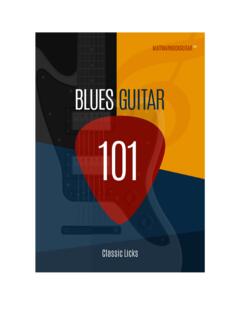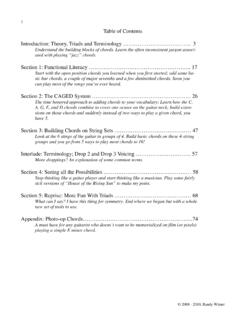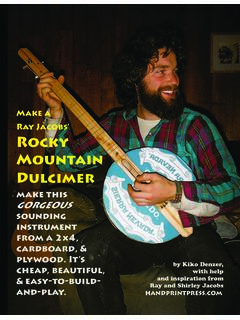Transcription of The Easy Guide to Jazz Guitar Arpeggios Samples
1 1 Sample PagesThis pdf contains sample pages from the ebook The Easy Guide to Jazz Guitar Arpeggios . To get the full ebook, Click Here2 ContentsIntroduction ..6 What Are Arpeggios ? ..7 Chapter 1: First Steps ..10 The ii-V-I-VI Progression ..10 The iim7 chord ..11 The V7 chord ..16 The Imaj7 chord ..19 The VI7b9 chord ..23 Chapter 2: Major ii-V-I-VI Arpeggios Position 1 ..26 Arpeggio Practice Pattern 1: Approach Notes ..28 Sample Licks ..32 Chapter 3: Major ii-V-I-VI Arpeggios Position 2 ..35 Apreggio Practice Pattern 2: Enclosures ..37 Arpeggio Sample Licks For Position 2 ..41 Chapter 4: Minor ii-V-I-bIII Overview ..43 The ii-V-I-bIII Progression.
2 43 The iim7b5 chord ..44 The V7b9 chord ..473 The Im6 chord ..51 The bIIImaj7 chord ..56 Chapter 5: Minor ii-V-I-bIII Arpeggios Position 1 ..60 Arpeggio Practice Pattern 3: Double Enclosure ..62 Sample Licks ..65 Chapter 6: Minor ii-V-I-bIII Position 2 ..67 Arpeggio Practice Pattern 4: Approach Notes Variation ..69 Sample Licks ..71 Chapter 7 Autumn Leaves Studies ..73 Autumn Leaves Arpeggio Study ..75 Arpeggio Study Variation 1 ..79 Arpeggio Study Variation 2 ..80 Arpeggio Study Variation 3 ..81 Autumn Leaves Arpeggio Solo ..82 Chapter 8 Major Turnaround Arpeggios Position 1 ..863 To 9 Arpeggios ..86 Arpeggio Practice Pattern 5: 7-1-3-5.
3 91 Sample Licks ..93 Chapter 9 Major Turnaround Arpeggios Position 2 ..96 Arpeggio Practice Pattern 6: 5-7-1-3 ..1004 Sample Licks ..102 Chapter 10 Minor Turnaround Arpeggios Position 1 ..105 Arpeggio Practice Pattern 7: 3-5-7-1 ..109 Sample Licks ..111 Chapter 11 Minor Turnaround Arpeggios Position 2 ..114 Arpeggio Practice Pattern 8: 5-7-3-1 ..117 Sample Licks ..119 Chapter 12 Rhythm Changes Studies ..122 Rhythm Changes Arpeggio Study ..123 Arpeggio Study Variations ..126 Rhythm Changes Arpeggio Solo ..129 Chapter 13 Must-Know Arpeggio Shapes ..132 Practice Example Exercises ..133 Maj7 Arpeggio Shapes ..137 Dominant 7th Arpeggio Shapes.
4 142 Minor 7th Arpeggio Shapes ..148 Minor 7b5th (Half Diminished) Arpeggio Shapes ..154 Diminished 7th Arpeggio Shapes ..160 Chapter 14 Some More Useful Arpeggio Shapes ..167 Maj7#11 Arpeggio Shapes ..1675 Dominant 7#11 Arpeggio Shapes ..170 Minor 6 Arpeggio Shapes ..172 Minor Major 7 Arpeggio Shapes ..174 Chapter 15: A Brief Look At Arpeggio Substitution ..176 Major 7 Arpeggios Used as Substitute ..176 Minor 7 Arpeggios Used as Substitute ..178 Dominant 7 Arpeggios Used as Substitute ..179 Half Diminished 7 (m7b5) Arpeggios Used as Substitute ..180 About the Author ..181 IntroductionWelcome to The Easy Guide to Jazz Guitar Arpeggios , we re glad to have you here!
5 In this eBook you will learn arpeggio theory, how to play jazz Arpeggios on the Guitar , how to use Arpeggios to improvise, as well as study practice patterns and sample solos built from the arpeggio fingerings in this Chapter builds on the previous material in the book. So, if you are new to jazz Guitar , you can start on page 1 and work forward from there. Or, if you have some experience playing jazz Guitar , you might want to skip around a bit, finding relevant chapters and exercises to what you are currently way, the material presented in this eBook will prepare you to outline chord progressions using Arpeggios in various positions on the fretboard.
6 This will enhance your ability to do one of the toughest tasks in jazz - make the changes - while outlining the chord tones for any chord you are soloing hope you enjoy this eBook and that the information contained within will give you countless hours of fun and benefit in the practice Playing!Matt Warnock & Dirk LaukensAbout the audio in this eBook: if you are connected to the internet while working in your ebook, all you have to do is click the link of each audio example to play it. If you are not connected, you ll have to download the audio files first Are Arpeggios ?Let s get started by learning what an arpeggio is exactly, and how the jazz definition of an arpeggio differs slightly from the classical arpeggio (in a jazz context) is the notes of any chord , played as single-notes, in note order.
7 In the classical world: an arpeggio is any chord played as single notes, regardless of the order. This means that if you take any chord shape you know, and pluck up and down the notes one at a time in that chord then you are playing a classical arpeggio. In the jazz world: in jazz, we put the notes in order. So, if you have a Cmaj7 chord , to make a jazz arpeggio to take the four notes from that chord (such as C-G-B-E), place them in note order (C-E-G-B), and you have an arpeggio. Here is how that looks on paper, try playing through all three to hear and feel how they sound on the Guitar . Bar 1: chord shape Bar 2: classical arpeggio Bar 3: jazz arpeggio Click here to play audio example 1 Audio Example 1 44&C 7 Classical ArpeggioJazz Arpeggio wwww 354535453254To help further your understanding of jazz Arpeggios , here is a Drop 3 Cmaj7 chord next to a two-octave Cmaj7 arpeggio.
8 You will see how the notes of the chord are in the arpeggio, but the arpeggio also fills in all the gaps so you play each note in order rather than spread out as in the case of the chord here to play audio example 2 Audio Example 2 Chapter 1: First StepsTo begin your study of jazz Guitar Arpeggios , we are going to take a look at one of the most commonly used chord progressions in jazz, the major ii-V-I-VI this chapter, you will learn: How to build each arpeggio in this progression. Two positions for two-octave Arpeggios . Some essential arpeggio patterns and ii-V-I-VI ProgressionThe examples in this chapter will be using the ii-V-I-VI progression in the key of G major:The iim7 ChordBuilt from the second degree of the major scale, the iim7 chord is a four-note chord with the interval structure 1-b3-5-b7.
9 You can also think of this arpeggio as the 1st, 3rd, 5th and 7th notes of the dorian mode, the second mode of the major help you visualize this arpeggio, here is a chart that lays out the intervals and notes for an Am7 arpeggio:Here is the one-octave A dorian shape next to a one-octave Am7 arpeggio, in order to see and hear how the Am7 arpeggio is derived from the A dorian here to play audio example 3 Audio Example 3 This arpeggio shape can be used to solo over iim7 chords. A one-octave shape is limited in its use though, that s why it s better to learn arpeggio shapes that cover more of the fretboard, like the following two-octave Am7 arpeggio shape with the root note on the 6th string.
10 Practice this this shape until you can play it fluently and by memory. Click here to play audio example 4 Audio Example 4 Here is a backing track that you can use to begin practicing improvisation with this arpeggio. The track is a static Am7 chord , so you can press play and then use the two-octave shape you just learned to begin soloing over this chord you are just running up and down the notes right now, or don t feel like you have a lot of ideas to work with at this point, that s fine. Just begin soloing with the arpeggio in order to get used to creating music with arpeggio shapes, and we ll work on building your soloing vocabulary as you progress through this eBook.






